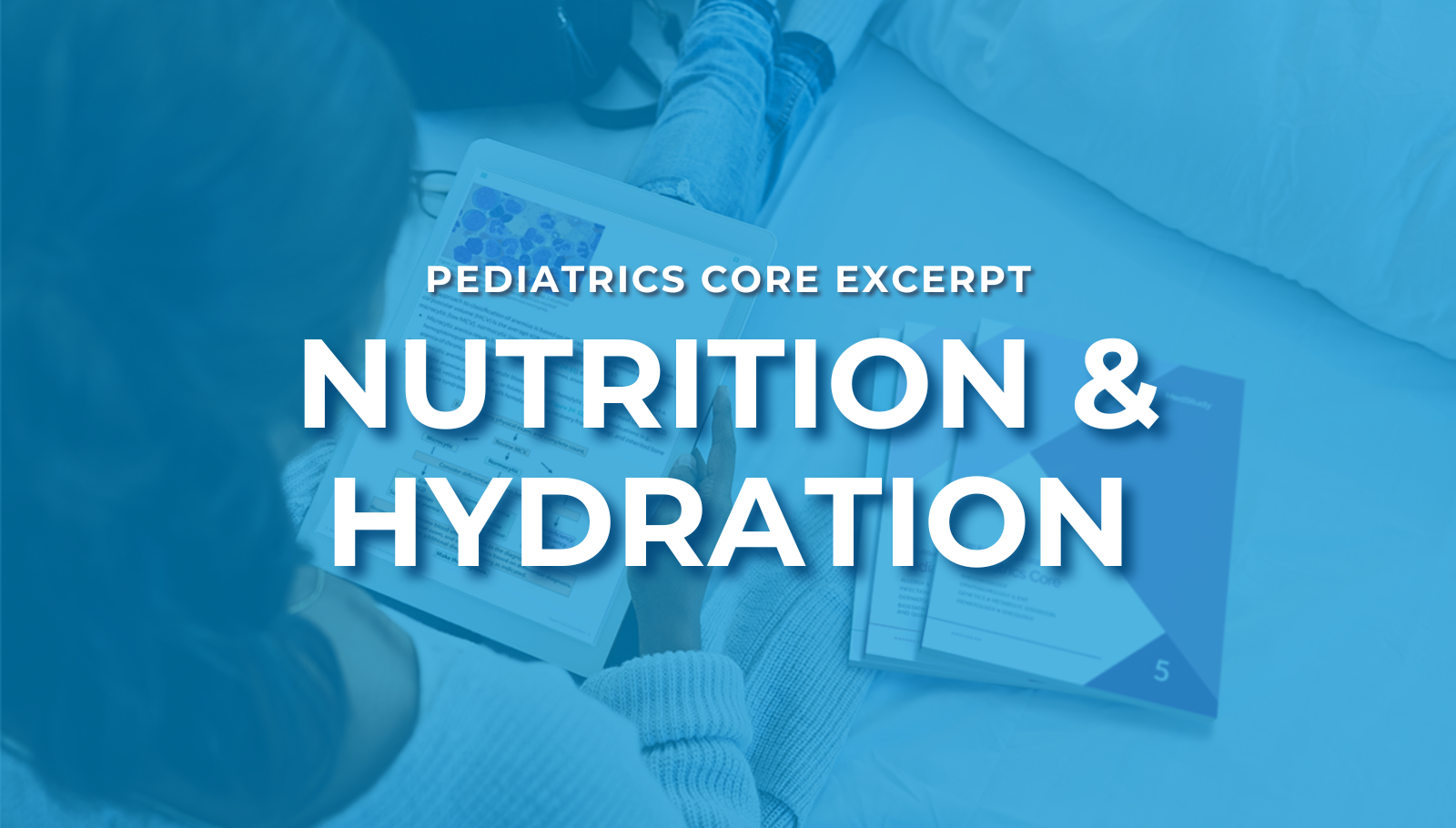Vital Nutrients, Fluids, and Care: What Every Busy Pediatrician Should Know about Normal Nutrition and Hydration

As a pediatrician, you influence your patients' good nutrition and eating habits from infancy through adolescence, and these good habits can create a foundation for life-long health. Along with that, proper nutrition and hydration help children maintain a healthy weight, strengthen immune systems, promote mental health, and so much more. So the work you do to coach your patients on these topics has both short- and long-term impact on their quality of life.
This excerpt from the Pediatrics Core reviews what you need to know about nutrition and hydration, and will come in handy the next time you're assessing nutritional habits and growth parameters as part of regular check-ups. Plus, identifying nutritional errors, eating disorders, and growth alterations early on allows for prompt treatment—and it's all highly board-relevant!What pediatricians need to know about normal nutrition
Preview | Review Question from the Pediatrics Core
Nutrition is important for normal growth and development. A healthy, balanced, diversified diet helps ensure that children obtain vital nutrients. A healthy diet is key for maintaining a healthy body weight as well as good cognitive and mental health. It may also help to prevent some forms of cancer and chronic diseases, such as Type 2 diabetes mellitus (DM). It is important for children > 1 year of age to eat a variety of foods from the 5 major food groups: vegetables, fruits, grains, protein, and dairy (or suitable nondairy alternative such as fortified soy milk or yogurt).
Advise parents to keep sugar intake to moderate levels. Since salt is an acquired taste, it is important to also advise parents to start low-salt meals early in life and not to add salt at the table.
Parents should help their children limit saturated fats and trans fats for improved heart health. High amounts of saturated fats are in animal-based products such as cured meats, butter, and full-fat dairy products, but coconut oil also contains a considerable amount. Trans fats are found in foods containing partially hydrogenated oil, such as baked goods, fried foods, shortening, and margarine. Consuming foods high in saturated fats and trans fats is associated with adverse cardiovascular outcomes.
The required amount of nutrients varies, depending on age and sex.
The USDA has provided detailed information on nutrition and health by life stage in their publication Dietary Guidelines for Americans, 2020–2025.
Fats have 9 kcal/g of potential energy while carbohydrates and protein have approximately 4 kcal/g. Dietary fat is the highest density source of potential energy. After 2 years of age, limit fats to < 30% of total calories.
Protein requirements per kilogram gradually decrease over time. The exception is during adolescence when protein requirements increase due to growth spurts. Adults require only 0.8 g/kg/day.
 Preterm infants are at risk for postnatal growth failure, and they have special nutritional requirements. The energy needs for term neonates are 100–120 kcal/kg/day, whereas preterm neonates need 100–150 kcal/kg/day.
Preterm infants are at risk for postnatal growth failure, and they have special nutritional requirements. The energy needs for term neonates are 100–120 kcal/kg/day, whereas preterm neonates need 100–150 kcal/kg/day.
Inadequate intake or overconsumption of certain nutrients can lead to various pediatric disorders (e.g., iron deficiency anemia can result from insufficient intake of iron or introduction of cow’s milk before 1 year of age).
Many conditions in childhood are associated with poor nutrient absorption and may require special nutritional intervention. For example, malabsorption can result from small bowel syndrome, liver disease, and cystic fibrosis. Those with small bowel syndrome are also at increased risk of zinc deficiency. Children with the following conditions commonly exhibit failure to thrive and thus may have greater energy and nutrient requirements:
-
-
- Chronic malnutrition
- Digestive tract diseases
- Kidney disease
- Heart disease
- Cystic fibrosis
-
Excess energy intake via food consumption relative to the amount of energy expended by physical activity can lead a child to become overweight or have obesity, which in turn can increase the risk of cardiovascular disease (e.g., hypertension, Type 2 DM) and development of certain cancers in adulthood (e.g., colorectal, breast).
What pediatricians need to know about hydration
Preview | Review Question from the Pediatrics Core
Many methods are available to treat and diagnose fluid and electrolyte abnormalities. Most are based on body weight and include the basal calorie method, the surface area method, and the Holliday-Segar formula. The first 2 methods require tables, while the latter formula can be used to answer exam questions on dehydration because this formula relates water loss to the caloric expenditure. Remember, these methods are approximations, and it is possible to underestimate or overestimate calorie requirements.
The Holliday-Segar formula for daily kcal required under basal conditions is:
100 kcal/kg for the first 10 kg plus
50 kcal/kg for the next 10 kg plus
20 kcal/kg for the rest of the weight
For example, the total kcal required per day for a 23-kg patient is:
(100 × 10) + (50 × 10) + (20 × 3)
or
1,000 + 500 + 60 = 1,560 kcal per day
Whether you're preparing for the boards or staying up-to-date for daily practice, this is what you need to know about normal nutrition and hydration. Dive into the Pediatrics Core to keep reviewing the rest of the topics from the ABP content outline! You're on a roll!






